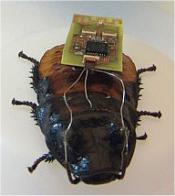Kinect can lead army of life saving cockroaches (Video)
Posted by: Jon on 06/26/2013 08:55 AM
[
 Comments
]
Comments
]
North Carolina State University researchers have been testing video game technology to remotely control cockroaches on auto pilot with a computer steering the cockroach through a controlled environment. The researchers are using the technology to track how roaches respond to the remote control, with the goal of developing ways that roaches on autopilot can be used to map dynamic environments – such as collapsed buildings.
 A NC State University news release says that researchers have incorporated Microsoft’s motion-sensing Kinect system into an electronic interface developed at NC State that can remotely control cockroaches. The researchers plug in a digitally plotted path for the roach, and use Kinect to identify and track the insect’s progress. The program then uses the Kinect tracking data to automatically steer the roach along the desired path.
A NC State University news release says that researchers have incorporated Microsoft’s motion-sensing Kinect system into an electronic interface developed at NC State that can remotely control cockroaches. The researchers plug in a digitally plotted path for the roach, and use Kinect to identify and track the insect’s progress. The program then uses the Kinect tracking data to automatically steer the roach along the desired path.
The program also uses Kinect to collect data on how the roaches respond to the electrical impulses from the remote-control interface. This data will help the researchers fine-tune the steering parameters needed to control the roaches more precisely.
“Our goal is to be able to guide these roaches as efficiently as possible, and our work with Kinect is helping us do that,” says Dr. Alper Bozkurt, an assistant professor of electrical and computer engineering at NC State and co-author of a paper on the work.
“We want to build on this program, incorporating mapping and radio frequency techniques that will allow us to use a small group of cockroaches to explore and map disaster sites,” Bozkurt says. “The autopilot program would control the roaches, sending them on the most efficient routes to provide rescuers with a comprehensive view of the situation.”
The roaches would also be equipped with sensors, such as microphones, to detect survivors in collapsed buildings or other disaster areas. “We may even be able to attach small speakers, which would allow rescuers to communicate with anyone who is trapped,” Bozkurt says.
 A NC State University news release says that researchers have incorporated Microsoft’s motion-sensing Kinect system into an electronic interface developed at NC State that can remotely control cockroaches. The researchers plug in a digitally plotted path for the roach, and use Kinect to identify and track the insect’s progress. The program then uses the Kinect tracking data to automatically steer the roach along the desired path.
A NC State University news release says that researchers have incorporated Microsoft’s motion-sensing Kinect system into an electronic interface developed at NC State that can remotely control cockroaches. The researchers plug in a digitally plotted path for the roach, and use Kinect to identify and track the insect’s progress. The program then uses the Kinect tracking data to automatically steer the roach along the desired path.The program also uses Kinect to collect data on how the roaches respond to the electrical impulses from the remote-control interface. This data will help the researchers fine-tune the steering parameters needed to control the roaches more precisely.
“Our goal is to be able to guide these roaches as efficiently as possible, and our work with Kinect is helping us do that,” says Dr. Alper Bozkurt, an assistant professor of electrical and computer engineering at NC State and co-author of a paper on the work.
“We want to build on this program, incorporating mapping and radio frequency techniques that will allow us to use a small group of cockroaches to explore and map disaster sites,” Bozkurt says. “The autopilot program would control the roaches, sending them on the most efficient routes to provide rescuers with a comprehensive view of the situation.”
The roaches would also be equipped with sensors, such as microphones, to detect survivors in collapsed buildings or other disaster areas. “We may even be able to attach small speakers, which would allow rescuers to communicate with anyone who is trapped,” Bozkurt says.
Comments






